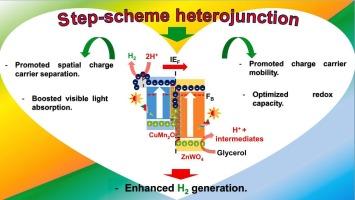介孔阶梯结构CuMn2O4/ZnWO4光催化剂的新设计:增强电荷分离和扩大光子吸收
IF 4.6
3区 材料科学
Q2 MATERIALS SCIENCE, MULTIDISCIPLINARY
引用次数: 0
摘要
复杂阶梯(S)型异质结的发展已经成为追求可持续氢生产的基础。本文首次采用湿浸渍法制备了具有不同CMO含量的新型介孔s型CuMn2O4/ZnWO4 (CMO/ZWO)异质结构光催化剂,并在催化过程中原位负载在光催化剂表面的共催化剂(Pt)存在下,从甘油-水混合物中产生可见光驱动的析氢。为了有效地生成H2,铂(Pt)作为一种典型的助催化剂,被用来克服相当大的过电位。此外,Pt共催化剂可以从光催化剂表面捕获光子激发的e - s。同时,甘油(一种生物质衍生物质)作为光子激发h+s的清除剂,提供质子(h+s),在Pt的帮助下,光子激发的e - s可以将质子(h+s)还原成H2气体。最有效的异质结构光催化剂9% CMO/ZWO具有广泛的比表面积(117 m2/g),二维骨架,介孔性质,改进的吸收边界(479.6 nm)和相对较小的带隙(2.66 eV)。此外,9%的CMO/ZWO具有分离光子激发电荷(电子/空穴:e−/h+)对的能力,并具有显著的氧化还原能力。结果表明,9% CMO/ZWO的H2产率为32.66(±1.633)mmol g−1,优化后的产率为4.16(±0.208)mmol h−1 g−1,分别是CMO和ZWO的12.2倍和139倍。五周期实验也揭示了9% CZ的显著稳定性。这种令人印象深刻的有效性的主要原因是S-scheme异质结构的发展,它改善了光子激发电荷的分离,增加了捕获和利用可见光的能力,并增强了氧化还原能力。本研究展示了一种创新的、实用的方法来制备更好的s型异质结光催化剂,用于高效、可靠地从水中制氢。本文章由计算机程序翻译,如有差异,请以英文原文为准。

Novel design of mesoporous step-scheme CuMn2O4/ZnWO4 photocatalyst for visible-light-induced H2 evolution: Enhancing charge separation and expanding light photon absorption
The development of sophisticated step (S)-type heterojunctions has become fundamental in the quest for the production of sustainable hydrogen. Herein, for the first time, novel mesoporous S-type CuMn2O4/ZnWO4 (CMO/ZWO) heterostructured photocatalysts were constructed with diverse CMO contents through a facile wet impregnation approach for visible-light-driven hydrogen evolution from a glycerol-water mixture in the presence of a co-catalyst (Pt), which was in situ loaded on the photocatalyst surface during the reactions. For achieving H2 generation effectively, platinum (Pt), as a typical co-catalyst, has been utilized to overcome the considerable overpotential. Moreover, Pt co-catalyst can capture the photon-excited e−s from the photocatalyst surface. Meanwhile glycerol (a biomass-derived substance) was served as scavenger for the photon-excited h+s, providing protons (H+s), which can be reduced by the photon-excited e−s into H2 gas with the assistance of Pt. The most effective heterostructured photocatalyst, 9 % CMO/ZWO, showcased an extensive surface area (117 m2/g), a two-dimensional (2D) skeleton, mesoporous qualities, an improved absorbing border (479.6 nm), and a relatively small band gap (2.66 eV). Moreover, the 9 % CMO/ZWO achieved substantial capability to separate photon-excited charge (electron/hole: e−/h+) pairs along with significant redox capacities. Hence, the 9 % CMO/ZWO generated an H2 amount of 32.66 (±1.633) mmol g−1 from, with an optimized rate of 4.16 (±0.208) mmol h−1 g−1, surpassing that attained utilizing bare CMO and bare ZWO by about 12.2 and 139 times, individually. Five-cycle experiments also unveiled the significant stability of 9 % CZ. The main reason for this impressive effectiveness is the development of the S-scheme heterostructure, which improved the separation of photon-excited charges, increased the ability to capture and use visible light, and enhanced the redox capacities. This research shows an innovative, practical way to create better S-scheme heterojunction photocatalysts for producing hydrogen from water efficiently and reliably.
求助全文
通过发布文献求助,成功后即可免费获取论文全文。
去求助
来源期刊

Materials Science and Engineering: B
工程技术-材料科学:综合
CiteScore
5.60
自引率
2.80%
发文量
481
审稿时长
3.5 months
期刊介绍:
The journal provides an international medium for the publication of theoretical and experimental studies and reviews related to the electronic, electrochemical, ionic, magnetic, optical, and biosensing properties of solid state materials in bulk, thin film and particulate forms. Papers dealing with synthesis, processing, characterization, structure, physical properties and computational aspects of nano-crystalline, crystalline, amorphous and glassy forms of ceramics, semiconductors, layered insertion compounds, low-dimensional compounds and systems, fast-ion conductors, polymers and dielectrics are viewed as suitable for publication. Articles focused on nano-structured aspects of these advanced solid-state materials will also be considered suitable.
 求助内容:
求助内容: 应助结果提醒方式:
应助结果提醒方式:


